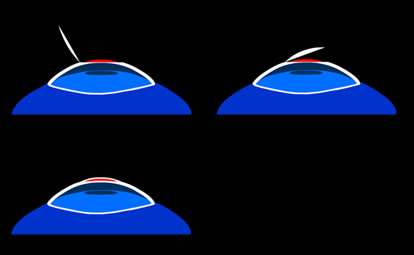

Stand
by for Implantable Contact Lenses
Martin
Drinkwater
Researchers
at the Cooperative Research Centre for Eye Research and
Technology (CRCERT) are working on a new method of vision
correction. Soon implantable contact lenses could become
a real alternative to laser eye surgery and long term
spectacle use.
As
many as one billion people worldwide suffer from some
type of vision problem. Many of these patients are seeking
permanent correction to free them from having to wear
glasses or contact lenses. Some people undergo laser eye
surgery, but this comes with strings attached. It is only
suitable for adults because it requires a ‘stable eye’.
This means that your eyeball has stopped growing and your
prescription has not changed for at least 18 months. Laser
surgery also results in loss of corneal tissue.
Researchers
at the Cooperative
Research Centre for Eye Research and Technology (CRCERT)
are working on a new method of vision correction - Implantable
contact lenses that could provide a convenient and safe
alternative to wearing glasses or having laser surgery.
 Diagram of an Implantable Contact Lens (ICL) |
A polymer lens is surgically implanted in the cornea. This changes the shape of the corneal surface, thereby achieving the desired refractive correction. The cornea is responsible for refracting light onto the back of your eye. It has five layers: the epithelium, Bowman's membrane, stroma, Descemet's membrane and the endothelium. The outer epithelial layer is a protective coating, just a few cell layers thick.
 layers of the cornea |
"Your body naturally regenerates the epithelium if the eye is injured," said Professor Brien Holden, Director of CRCERT. "During the surgical procedure, we remove the epithelium and place the implantable contact lens directly on top of the cleaned Bowman’s membrane. The epithelium then regrows over the contact lens."
The
synthetic lens is made from a perfluoropolyether (PFPE),
a highly porous polymer with fluorine atoms replacing
the hydrogen 'ribs' attached to the carbon 'backbone'.
During the polymerisation process, nanometre-sized pores
are formed in the lens. This allows oxygen to pass through
the lens, keeping the cornea healthy and reducing the
risk of eye infection.
"We aim to design the implantable contact lens so
that it will provide a stable refractive outcome for at
least five years," said Professor Holden. "If
a patient's prescription changes, the lens can be replaced
in a reversible surgical procedure. No permanent damage
is done to the crucial stromal tissue. If this process
is successful, people could throw away their glasses and
contact lenses!"
OnSET is an initiative of the Science Communication Program
URL: http://www.onset.unsw.edu.au/ Enquiries: onset@unsw.edu.au
Authorised by: Will Rifkin, Science Communication
Site updated: 7 Febuary, 2006 © UNSW 2006 | Disclaimer
OnSET is an online science magazine, written and produced by students.
![]()
OnSET Issue 6 launches for O-Week 2006!
![]()
Worldwide
Day in Science
University
students from around the world are taking a snapshot
of scientific endeavour.
Sunswift
III
The UNSW Solar Racing Team is embarking
on an exciting new project, to design and build the
most advanced solar car ever built in Australia.
![]()
Outreach
Centre for Sciences
UNSW Science students can visit your school
to present an exciting Science Show or planetarium
session.
![]()
South
Pole Diaries
Follow the daily adventures of UNSW astronomers
at the South Pole and Dome C through these diaries.
News in Science
UNSW is not responsible for the content of
these external sites